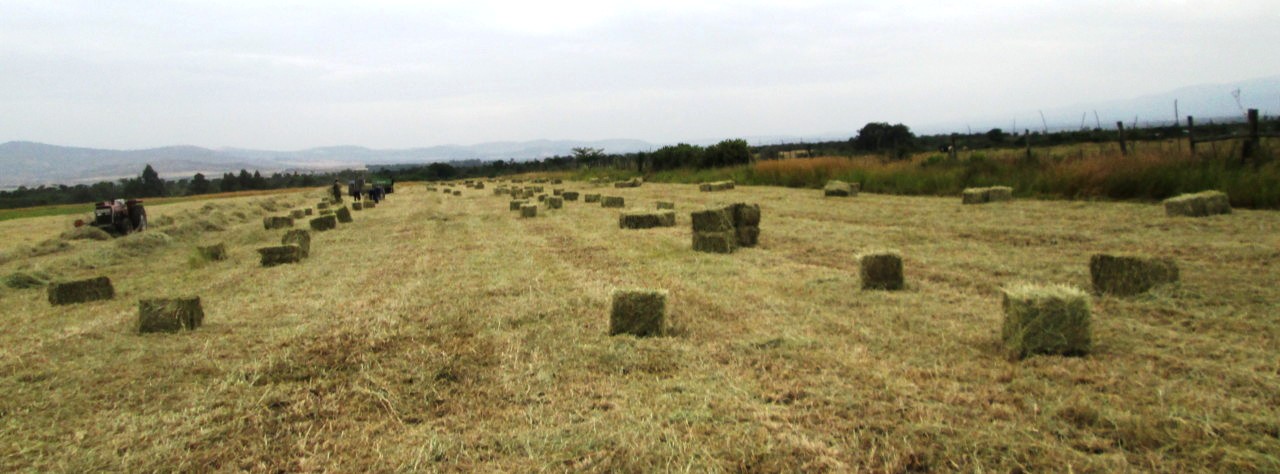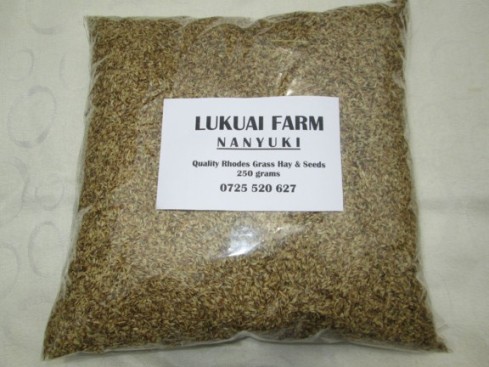
ECHOcommunity member Anne Munene is a hay farmer, trainer, consultant and blogger in Nanyuki Kenya. This week's post is from her blog "Lukuai Hay Farm" originally posted here: https://lukuaihayfarm.wordpress.com/2016/09/28/end-of-hay-baling-season-lessons-learnt
We are close to the end our baling season and what a time we have had; with challenges that could fill a barn and lessons from sources that we didn’t expect. On a very personal level I have had tremendous support from the Lukuai Farm staff and neighbours, for which I am truly grateful.
In this post I mainly want to address the challenges in hay production especially at a time when there is a new hype that pesa iko kwa hay. Ok, that if you have some idle land and plant “hay”, this will be better than betting. You will get rich, and very fast while we are at it, with the best part being that you don’t have to sweat it out, it is easy money.
Aaah, I guess I stood on the wrong side of this mythical generous wind that blows money into hay producers, while still allowing them to live the easy life of lounging about.
Sorry to break the hay riches bubble, but commercial hay production is hard work, with start-up costs which can be draining and like all business ventures it has its risks.
While there are many “consultants” who are giving very rosy financial figures about hay earnings, it is important that prospective hay producers get realistic ground information to enable them to make informed decisions on if they should go into hay production.
Things to consider:
Region / Zone
In business they say location is key, and so it is in hay production – this determines the amount of rain you receive and consequently the species of grass or legume (e.g. Lucern) that you can grow.
Particularly for farms that are in ASALs (Arid and Semi-arid Lands), such as Lukuai Farm, you will not have the luxury of rain like farmers have in the Rift Valley, therefore management decisions must be geared towards keeping your soils fertile coupled with water conservation, so as to get the maximum yield even under low rainfall.
What is the condition of the land you are starting from?
Have you fenced? You would consider this a rhetoric question especially to those with non-occupied farms: you need to fence, and with a good fence that can keep off small livestock e.g. sheep.
Don’t try to sugarcoat it with the excuse of: “Oh, there are no people around my area.” (Huko ni wapi? ) You need to fence if your intention is to become a commercial hay producer.
Is it virgin land?
If yes, this is a big advantage because the soil fertility may be high (assuming the land is not eroded), but it can also be a disadvantage if you have to factor in the cost of opening land by uprooting tree stumps etc. This is expensive, especially if the native bush is of the stubborn acacia family. I should know this as Lukuai Farm was (and part of it still is) inhabited by acacias.

If land has previously been cultivated, you owe the previous occupiers a big cup of tea as they have saved you a huge expense and gained you valuable time.
Choice of Grass
Rhodes Grass hay remains the favourite species for dairy farmers and many commercial hay producers prefer to grow it because it is easily recognisable as the main hay brand. However, other grasses, e.g. Timothy, Star, Red Oat and Kikuyu Grass, are equally good and with good management can deliver as good returns.
Source of Seeds

This can’t be over emphasized: know the source of your seeds and be careful that you don’t introduce undesirable plant species in your farm by sourcing seeds from unreliable vendors.
Method of planting
Depending on your location and the condition of the land, you could decide to establish a pure stand of grass, e.g. Rhodes Grass, or you could use minimum tillage and over seeding of Rhodes Grass on indigenous grasses. The latter is especially useful in areas that are rainfall-challenged.
Machinery
Hay baling is 100% machine dependent, and it doesn’t come cheap, whether one outsources baling or uses their own machines.
The quality of hay depends, among other factors, on the stage of its harvesting. Once the right leave:stem ratio stage has been attained (the early flowering/boot stage), the quality starts to decline with every day that the grass remains uncut.
So if you outsource baling, be on speed dial with your baling contractor. And if your acreage demands that you be self-sufficient in machinery – however long it takes – aim to get your own set(s) of baling machines.
Storage

One of the biggest stretch of money-in-the-hay hype is that there are ready buyers, who will buy all your hay straight off the field and you don’t need to store it. Call them brokers or traders, they will buy your hay (though not always) but because they know you don’t have a barn, you are totally disadvantaged in negotiating the price.
The reality is that hay is perishable, especially when exposed to rain, so if you don’t have a barn, you either sell it at whatever price or keep watching the skies.
Marketing
Why, why would you put effort to produce a crop and make no effort whatsoever in marketing? All too often I meet (or I am contacted by) hay producers, who are seeking help in marketing their hay. The irony is, many of them are waiting for the buyers (dairy farmers) to come to their farms, instead of them going to look for the dairy farmers.
If you are a hay producer and you are not talking directly to your market, hapo kuna shida.
Consider that hay, whether in your store or as mature grass in the farm, is an inventory and like in any other business, inventories are expensive to hold and have associated risks. Your marketing objective should aim to give you the best price and also reduce the amount of time you hold the hay.
You can contact Anne, and read more of her blog posts on running a successful hay business on her blog: https://lukuaihayfarm.wordpress.com
Do you have a guest post you'd like to share with the community? Use the "Contact Us" form to submit your story.